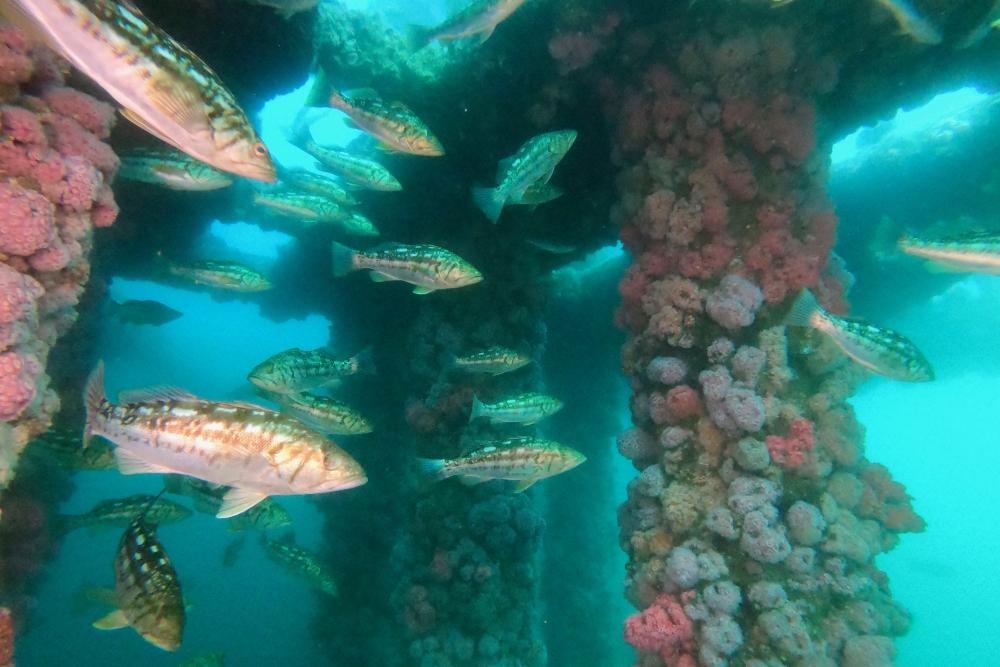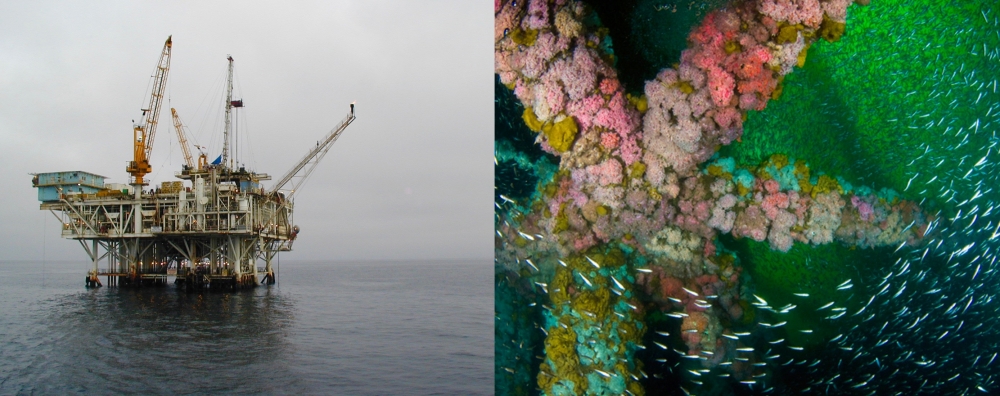
Take It or Leave It



The oil platforms off the Santa Barbara coast are a familiar sight to local residents. The structures tower above the ocean surface like industrial factories. But below the water, the rigs are like high-rise apartment buildings, providing homes to a vibrant community of sea life.
Of California’s 23 federal offshore platforms, many are nearing the end of their lives, and regulators need to decide what to do with the underwater superstructures. Some advocate removing the platforms in their entirety, while others propose leaving their support structures in place to continue acting as human-made reefs.
In an effort to inform this discussion, a group of researchers led by scientists at UC Santa Barbara has produced 11 studies in a dedicated issue of the Bulletin of Marine Science outlining the ecology of the state’s oil platforms. They’ve also compiled a searchable database of studies on platform ecology carried out worldwide.
“Platforms are going to be decommissioned and California citizens should make informed decisions about this process,” said Ann Scarborough-Bull, a researcher at UCSB’s Marine Science Institute (MSI), who spearheaded the initiative. She will speak about the topic January 13 at the Offshore Oil Platform Decommissioning Forum, which will take place at the Aquarium of the Pacific in Long Beach, California.
Scarborough-Bull and her colleagues have been investigating the ecology of oil platforms for over 20 years. In that time, they’ve found that a platform’s intricate network scaffolding provides an ideal structure for invertebrates to colonize. The reef soon attracts fish, and a thriving ecosystem develops.
“On average, as far as fishes are concerned, platforms are more productive than natural reefs in Southern California,” said research biologist Milton Love, also at MSI.
“And, in fact, if you look at aquatic habitats around the world, California platforms are some of the most productive anywhere,” he added.
A grand summary
More than two decades of research adds up to a lot of studies, and there was no easy way for citizens and policymakers to grapple with all the material. Love and Scarborough-Bull knew that the community needed a summary of the information from all of this work. “Fortunately, the federal government was willing to fund this summary,” said Scarborough-Bull.
Indeed, the Bureau of Ocean Energy Management (BOEM) — an agency in the Department of the Interior — provided $400,000 for the endeavor.
“It was important that this compendium be a reputable, peer-reviewed undertaking through a marine science journal,” said Scarborough-Bull. She and Love approached the editorial board of the Bulletin of Marine Science about publishing an issue of the journal dedicated to this topic. The two of them then coordinated with 20 colleagues at UC Santa Barbara and other institutions to put together the articles for the issue.
Beginning with an introductory paper by Love, the issue explores many aspects of platform ecology. The research discusses the diversity, movements and behaviors of fishes around the platform reefs and compares them with natural reefs nearby. The papers also investigate where fish larvae at platforms come from, and where the larvae of mature platform residents end up.
For instance, the researchers found that the offshore oil platforms supply fish larvae to nearshore habitats in the Santa Barbara Channel. “Tiny planktonic eggs and larvae ride a very complex course of ocean currents from one place to another,” said Mary Nishimoto, a research associate at MSI. “Our larval tracking model showed that fish reproducing at distant platforms off Huntington Beach, 100 miles from Santa Barbara, can help to replenish populations in the channel, as can fishes at platforms within the region.”

Giant sea stars feed on mussels growing on the leg of an oil platform.
Photo Credit: ANN SCARBOROUGH BULL
Not simply focused on fish, the issue also analyzes the composition of the reefs’ invertebrate communities, from those that live near the surface to those that form the structure of the reef — like corals, sponges and anemones — to denizens of the shell mounds that build up on the sea floor below. Perhaps most importantly, the research examines the effects of different decommissioning strategies.
Taken together, these studies form a comprehensive account of the interplay between marine life and oil platforms off the California coast. What’s more, all the articles are open access and freely available to the public.
The Bulletin of Marine Science special issue was only one aspect of the project. Love also compiled a searchable database of all the studies ever conducted on platform ecology worldwide. The website cross-references more than 1,000 papers.
Time and place
In 2010, California passed the Marine Resources Legacy Act, which allows regulators to consider leaving parts of a platform in place to continue serving as a human-made reef during the decommissioning process. These would then be accepted into the state’s artificial reef program.
This doesn’t, however, absolve oil companies of their duties to retire the platforms. The companies must still deal with the structure above the water and properly seal the wells. What’s more, they retain responsibility for the integrity and condition of the wells indefinitely, Scarborough-Bull explained.
In other places, like the Gulf of Mexico, fishermen realized that these structures provided habitat to fish and fishing opportunities, and they wanted these reefs to remain in place. Leaving the platforms’ scaffolding to continue serving as a reef has since become policy in several other states and countries.
“But because it’s much more of a controversial issue here in California, the science may play a much bigger role in that decision,” Nishimoto said.

The industrial visage of platform Gilda contrasts sharply with the vibrant reef that has formed below it.
Photo Credit: ANN SCARBOROUGH BULL
“In my mind, the take-home message from reading the papers is that platforms are fully functioning reefs,” said Love.
Given this finding, why rip out the entire platform, asked Scarborough-Bull. You can compare the structures to shipwrecks, which are commonly left as human-made reefs. And these platforms create even better reefs than shipwrecks, she added.
Still, the researchers emphasized that, professionally, they maintain a neutral stance on the issue. However, it’s hard not to draw conclusions after so many years working on a topic.
“The question is, how important are the scientific findings on platform ecology when deciding what to do with those platforms that no longer produce oil or gas,” asked Nishimoto. “Do you want platforms completely removed or do you want to leave them in, and what will be the consequences of either action?”



